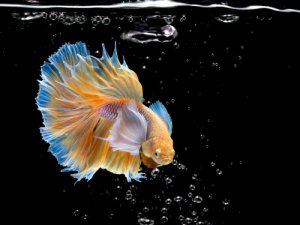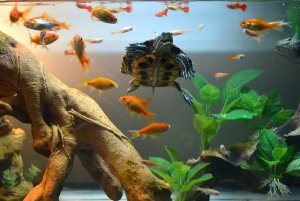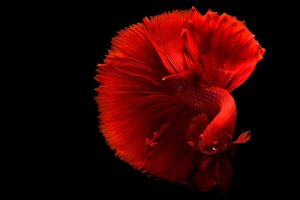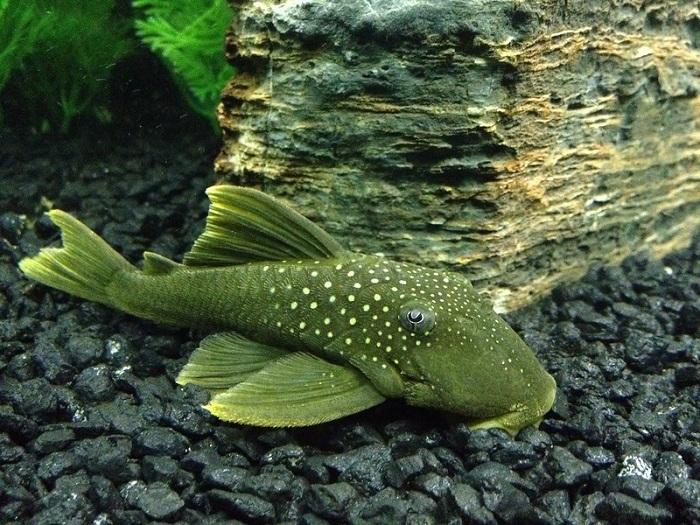
The Green Phantom Pleco is a shy fish with a delicate green appearance that can make a wonderful addition to your tank. These fish come from the Orinoco river basin in Venezuela, where they feed on algae and driftwood. Having one in your tank not only provides interest but also helps keep it clean! Read on for a guide on how to look after these fascinating fish.
Breed Overview
| Origin | Orinoco River, Venezuela |
| Lifespan | 5-8 years, can live up to 15 years if well cared for |
| Size | Max 6-7” or 15 cm |
| Colors | Bottle green |
| Food | Omnivorous, algae eating |
| Tank Size | Minimum 30 gallons/114 liters |
| Temperament | Peaceful, but can be territorial |
| Water type | Fast-flowing freshwater |
| Water Temperature | 72-78 F/22-26 C |
| Water pH | Neutral |
| Difficulty level | Beginner |
Appearance
The Green Phantom Pleco is a medium-sized Pleco with a dark mottled green color and white polka dots. It is a distinctive-looking fish that likes nothing better than scavenging for food at the bottom of the tank. The Green Phantom Pleco has a bulbous head and a long, tapering tail. It does not have scales but instead has armored skin, especially on its stomach.
The Green Phantom Pleco also has an impressive, triangular-shaped dorsal fin that stands up on its back. This can make your fish’s height much taller than it otherwise would be. They do fold their fin down occasionally, however, in order to squeeze into nooks and crannies.
Author’s Note: Green Phantom Plecos have sensitive skin. This means it’s important to be extra careful when transporting them for any reason. Cutting their skin on driftwood or other tank decorations can easily be a recipe for infection (see pests and diseases section below)
Choosing A Green Phantom Pleco
The Green Phantom Pleco is part of the loricariidae family, the most species-rich catfish family. Pleco fish in general are understudied by science, and many have only become popular within the last few decades.
As a result, the name Green Phantom Pleco can refer to several similar-looking species. To mitigate the difficulties with classifying these fish by their scientific names, the aquarium trade uses L-numbers to indicate fish that are close enough that they can be treated as a single species. Therefore, if you’re looking for a Green Phantom Pleco, look out for the number L-200.
Tank Setup And Maintenance
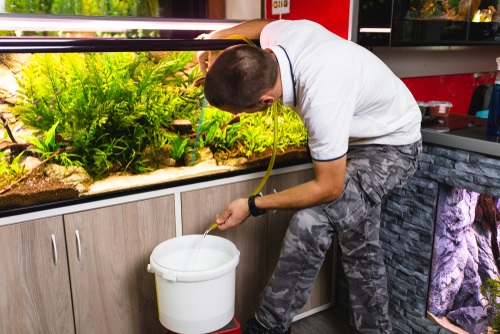
One of the most crucial and important things about setting up a tank for any Pleco is to choose the right substrate. Plecos feed on the bottom of the tank, and as a result, a gravelly or sharp substrate can hurt their delicate stomachs, even though these are described as armored. Apart from this, these Plecos do well with the following setup:
- Plant your tank appropriately. In their native habitat in the Orinoco River basin, the Green Phantom Pleco enjoys hiding amongst rocks, plants, and driftwood. Including these in a tank help your fish feel secure and sheltered from predation. This can also help them come out into the open to feed.
- A Green Phantom Pleco should have a tank that is a minimum of 30 gallons/114 liters, and this is just for your Pleco alone – not counting any tankmates! Despite starting small, these fish can grow quite big, plus, having plenty of territory and places to hide helps their well-being.
- If making a community tank, understand what conditions different fish like. Not all Plecos tolerate the same temperatures. However, the clown Pleco has similar needs regards temperature and pH, so as a rule of thumb, tankmates like the zebra danio that work with clown Plecos, will also work with your Green Phantom Pleco.
- The other key point is that the water is flowing, clear, and well-oxygenated. You can achieve this with a circulation pump; however, you should check this is compatible with any tankmates you choose to include. You should use a strong filter that is at least 4x the tank capacity. Just bear in mind these guys are not strong swimmers. Always change a third of the per week to maintain cleanliness.
Tankmates
Plecos get on well with a wide variety of tankmates. However, choosing tankmates that live in similar conditions in the wild ensures the water qualities are correct for all fish.
The Green Phantom Pleco lives in fast-flowing river tributaries. It may seem that all Pleco species need similar water conditions. However, while some Plecos like blackwaters with lots of organic matter, the Green Phantom Pleco prefers crystal-clear water. Therefore, choose tankmates who like similar conditions. These include:
- Rasboras
- Cory catfish
- Rummynose tetra
- Neon tetra
- Pencilfish
One relative exception is angelfish. Angelfish generally prefer softer water, but luckily Plecos are hardy and they can thrive alongside angelfish. In fact, an Amazonian community tank for many kinds of Pleco can be based around good angelfish tankmates. Plecos thrive in this kind of tank alongside fish like the Cory Catfish.
Author’s Note: One thing to know is never to mix a Green Phantom Pleco with other bottom-dwelling catfish. If you want to pair them with other bottom dwellers, make sure you have room! But as a rule of thumb, due to their timid nature which means they can act aggressively in self-defense, these guys don’t get on well with other bottom-dwellers entering their territory. This is especially true with other Plecos, and the green Phantom should never be mixed with these.
Feeding
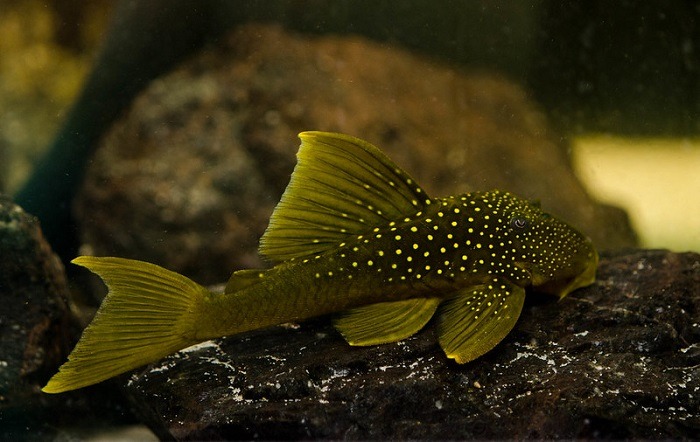
What do you feed a Green Phantom Pleco? Fortunately, feeding this kind of Pleco doesn’t have to be complicated. These fish are bottom feeders and will scavenge for most of their food on the bottom of the tank. As a result, you may worry they are getting enough nutrients.
Many catfish species endure feast and famine conditions in the wild and they have evolved to scavenge on a wide variety of foods as a result of this. Yet, despite their scavenging nature, you should never leave a Green Phantom Pleco to their own devices in terms of food. Instead, you should feed them with algae wafers, which can be purchased in any good aquatics store. These are flakes of algae that sink to the bottom of your tank for your fish to eat. Ideally, you should feed one or two per day.
However, this doesn’t mean you can’t give your Pleco occasional treats. Green Phantom Plecos are not solely vegetarian, and they still enjoy the occasional protein. Only ever feed frozen protein, as these guys are not strong swimmers and will find it hard to catch live protein. Frozen bloodworms or tubifex worms are a great choice. In addition to protein, you can feed them blanched vegetables such as bits of zucchini, lettuce, or half a shelled pea.
Behavior And Temperament
Generally, Green Phantom Plecos are peaceful fish. The one thing aquarium keepers need to worry about is how territorial their tankmates are, as opposed to the Plecos themselves. In fact, aggression is much more likely to come from potential tankmates than it is from your Pleco.
Plecos are shy fish in general, and the Green Phantom Pleco is no different. They do not like rapid approaches from other fish and they are more likely to be on the receiving end of any territorial behavior. When they feel threatened, they tend to hide in the crevices between rocks, plants, or pieces of driftwood.
You can ensure they feel safe by making sure all tankmates are also peaceful species. In addition, having a tank that is at least 30 gallons or 114 liters prevents any territorial disputes between fish.
Author’s Note: Pleco’s don’t just hide away! These are friendly fish, and they can learn when it is time for food. In this case, they may even come up to the front of the glass and approach you as you walk over to their tank. Despite their shyness and preference for caves, they are actually quite active. Therefore, take any lethargy as a sign something may be wrong or your fish is sick.
Pests And Diseases
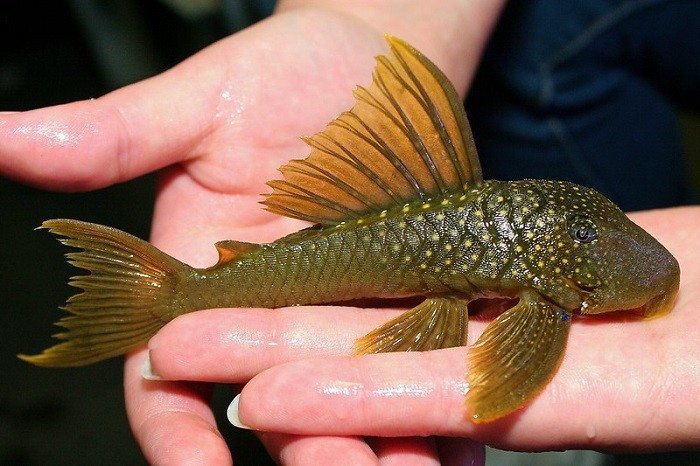
Ich
Ich is a common parasitic infection that can be fatal, but doesn’t have to be if you catch it early. It’s quite easy to spot because it can appear as white blotches or patches on your fish’s skin. Just don’t mistake it for your fish’s natural polka dot coloration!
However, it can be treated like any fungal infection; by quarantining the fish and adding an antifungal treatment to the water.
White Fungus
White fungus is a parasitic infection that can appear as white fuzzy growths on your fish. It can be especially noticeable on Plecos due to their smooth skin, and you may worry about how this disease affects your fish’s well-being. Fortunately, the white fungus isn’t fatal. Instead, you can treat it with over-the-counter antifungal treatments that can be purchased at any good aquatics store. However, ensure you quarantine your Pleco in a separate tank first, so these medicines do not affect your healthy fish.
Fin Rot
Fin rot is a bacterial infection that is common to many species of freshwater fish, both tropical and coldwater. In the Green Phantom Pleco, it can affect both the tail fin and the fish’s dramatic dorsal fin. Telltale signs are the edges of the fins looking sore or ragged.
As a bacterial infection, fin rot can be treated by quarantining the fish, changing the water regularly (every day is sometimes recommended while your fish is recovering), and using over-the-counter antibacterial medication.
Parasites
Parasitic infections can affect all fish, but on your Green Phantom Pleco parasites such as flukes may attach near your fish’s gills or on their smooth skin. You may notice changes in the behavior of your Pleco before you notice any actual parasite.s This is because they can drain the energy of your normally lively fish, and make them lethargic.
Fortunately, parasitic infections can be treated by quarantining the fish in a separate tank and using over-the-counter medication. They are not life-threatening, and your Pleco will return to normal in a few days.
Breeding
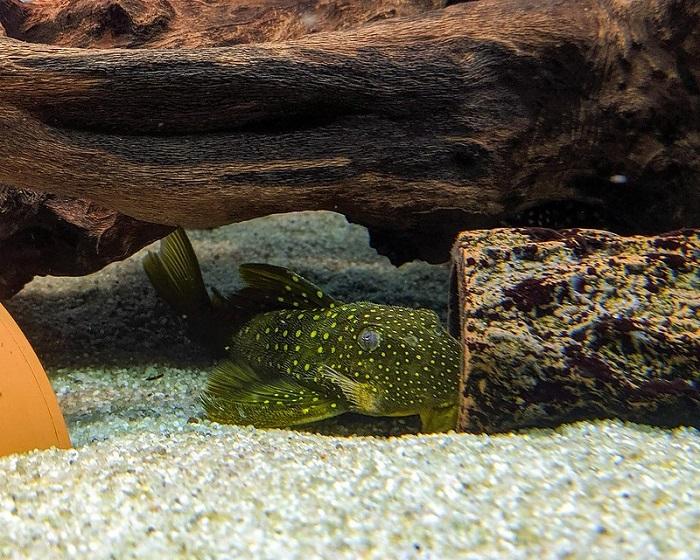
Breeding the Green Phantom Pleco is difficult. Many Plecos you see in aquatics stores are wild-caught. What’s great is if you do manage to get them to breed, the male Green Phantom Pleco is a devoted parent who looks after the eggs and fries really well.
In order to breed these fish, the best thing is to encourage their natural tendencies. For starters, you will need to help them feel safe enough to breed. The following steps will help you encourage spawning, even if you are a novice breeder.
- Provide plenty of caves. In the wild, the male Green Phantom Pleco digs a cave for the female to lay eggs in, which he then fertilizes with his milt. You can mimic this in captivity by making caves out of rocks and driftwood, though many aquarists even use PVC piping ad it offers a safe and snug nook for your fish to hide in.
- Introduce the male and the female. You will see that they begin to hang around each other and go into caves and hidey-holes together.
- Eventually, you will see that if the female is comfortable with the male and feels ready to mate, she will lay her eggs in a cave or secluded spot. The eggs are relatively large, and they are bright yellow. The female can actually lay over 40 eggs!
- At this point, it’s a good idea to remove the female, after you are sure that the male has done his bit and sprayed his milt over the eggs. However, it’s best advised to leave the male in. In the wild, the male tends to protect the eggs from predators. Even though your breeding tank will be safe and predator free, the presence of the male next to the eggs will not only make him less stressed. Plus, there are reports that this is more hygienic as human interference with the eggs can introduce bacteria.
- The male will do an excellent job at guarding the eggs until they hatch. If you are lucky enough to get these fish to breed in captivity, this can be delightful to watch.
- Once the fry have hatched, you can remove the male. Green Phantom Pleco fry will feed off the yolk sac of their eggs for up to 6 days after hatching! This means you don’t actually have to give them any food immediately.
- Once the fry have used up their eggs sacs, you can start feeding them baby brine shrimp. These fry are generally large, but they may still struggle to eat full-sized adult invertebrates at this stage.
Final Thoughts
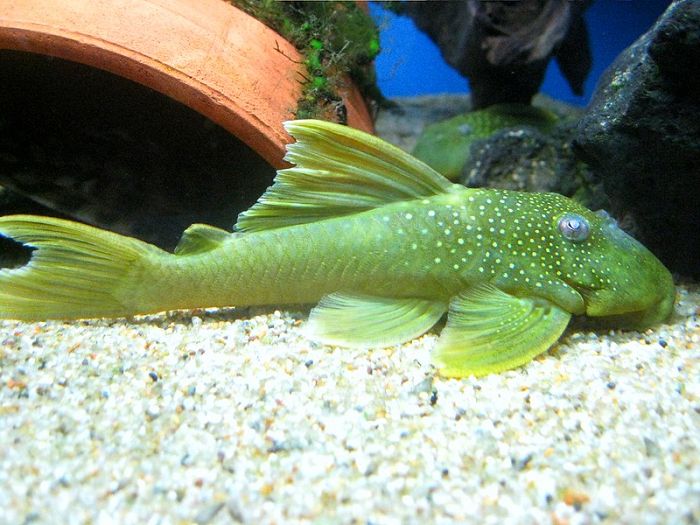
Overall, the Green Phantom Pleco is an exciting and relatively recently discovered Pleco species that still have a lot that is unknown about it. Its stunning coloring and compatibility with many other popular aquarium fish make it a great choice for fishkeepers who want something a little different for their tank. On top of this, its ease of care combined with its relatively sociable and interactive behavior makes it a great fish that will capture the attention of both beginners and experts alike.


